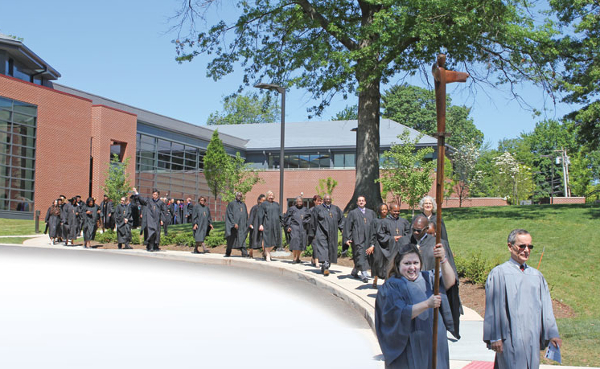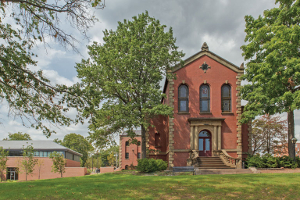
The class of 2015 processes to Kirkpatrick Chapel for commencement on May 23, 2015.
Shortly after New Brunswick Theological Seminary (NBTS) sold half of its acreage and 10 of its 11 buildings in New Brunswick, New Jersey, President Gregg Mast led the school’s trustees on a solemn walk through the campus. They paused at aging dormitories and historic classroom structures — each soon to be demolished — and shared a prayer of gratitude for the people who once lived and worked there.
“I’m not sure there was a dry eye in the group,” recalls David Cooper, moderator of the governing board at the time. “But some were tears of joy. Yes, change was going to happen and, yes, it was going to be fantastic.”
The complex deal was several years in the making. Among the oldest seminaries in North America, New Brunswick has reinvented itself many times in response to economic crises, personnel problems, enrollment dips, and shifts in student populations. Until just two years ago, the seminary was perched atop “Holy Hill” and surrounded like a donut by Rutgers University, so locals have sometimes called it either the “hole” or the “soul” of Rutgers, which is a state university.
By the time Mast arrived in 2006, both schools — independent of each other — were grappling with serious space problems. The university needed more; the seminary, less.
“We were land rich and budget poor,” explains Mast, himself an alumnus of the 231-year-old seminary. Over the course of several years, the school’s reserves had been depleted, and millions had been borrowed from its modest endowment. Half of the buildings dated back to the 19th century, and all had deferred maintenance problems. One dormitory was shuttered rather than undergoing a massive makeover estimated at $4 million.
Cooper, the head of the governing board, is an architect. He describes the old buildings as “fortress-like,” and the main classroom building — vintage 1967 — as nondescript.
Adding to these headaches, the seminary was trying to adjust to the needs of its changing enrollment. No longer dominated by the sons of old Dutch families training for ministry in the Reformed Church, the academic program was attracting a diverse mix of men and women from various racial and ethnic backgrounds and more than 20 denominations. There were second-career and bi-vocational students. And there were many commuters who had no need for living quarters but were frustrated by the lack of parking.
Hard sell: Time to downsize
“Clearly we had changed to an urban ministry concept,” says Cooper, a veteran board member who agreed to serve another term to help the school navigate the sea of red ink. “We didn’t need seven and a half acres any longer. Three acres would be more than enough.”
Still, winning support for selling part of the campus required years of conversations that ranged from coolly pragmatic to hotly emotional. “Some folks believe you should never sell land,” explains Cooper. “We worked hard to build consensus by listening to all kinds of alternatives. No one was shut out of the process. The board, our alumni, our faculty, and especially our students had a voice at the table.”
Cathy Proctor, director of development, says downsizing was the popular topic of conversation when she joined the seminary staff several years ago, but it took until 2013 for a decision to be made to sell part of the campus. “It was a long process with a lot of talk and a lot of pain,” she recalls. “As president, Dr. Mast probably could have gotten a nod from the board to move forward, but he wanted a unanimous vote. This came through patience, perseverance, and having the right people in place.”
 |
| The Gardner A. Sage Library is called the "jewel of the campus," and the new building (below, right) was designed to complement it. |
From the beginning, all stakeholders agreed on one important point. Any vision for the future had to include the stately Gardner Sage Library, the most historic building on campus. “That was at the center of everyone’s heart,” says Cooper. Dormitories and faculty housing could go, but any new seminary building, technologically smart and environmentally green, would need to fit in comfortably with the library, which was built in 1875.
“As architects, we talk about buildings ‘relating to one another,’” Cooper says. “We wanted these two buildings — the new seminary building and the Sage Library — to coexist around a courtyard where our history and our future could be intertwined. The goal was for people to be able to say, ‘We’re not abandoning our history, we’re reinforcing our future.’ In that way we were able to bring all the stakeholders together.”
In the end, the logical option was to use the land to ensure the future. Returning the school to fiscal stability, replenishing the reserves and endowment, and building a debt-free facility and new parking lot were key components of the seminary’s master plan.
Implementing such a plan would be pricey — an estimated $30 million. President Mast recruited a team of outside mentors and experts who walked alongside the in-house leaders as they took steps to pare the operating budget and leverage the school’s real estate in service of its mission. A key to their success was a steadfast determination to hold out for a deal that would deliver the school to solvency.
Recruiting a support team
Consultant Anthony Ruger coached the seminary leaders for three years, meeting periodically with Mast, the chief financial officer, and the chair of the board’s finance committee. Their focus was how to achieve “economic equilibrium,” an effort Mast describes as “looking closely at finances and finding balance between income and disbursements.” Ruger also spent an evening with the trustees, answering questions and bringing them up to speed on ways to establish a new institutional culture that would prevent another fiscal meltdown in the future.
Key players in negotiating a favorable deal with Rutgers University included the state’s top real estate executive — a friend of Mast’s — and the New Brunswick Development Corporation (DEVCO), a nonprofit real estate developer that worked closely with university and civic leaders to revitalize the local community. In the fall of 2013, the seminary sold five acres not to Rutgers but to DEVCO, which Rutgers had retained to develop the newly acquired property for the university’s benefit. The seminary later purchased a one-acre parcel from Rutgers for $1 to accommodate a parking lot.
What began as a $30 million transaction to meet the seminary’s needs expanded into a $330 million project as Rutgers used the land acquisition to jumpstart an extensive makeover of its campus. Plans for a new honors college, classrooms, offices, and residence hall moved from Rutgers’ wish list to reality. “Our piece of the deal was the first and instrumental piece,” says Mast, “but it then became a small piece of a much, much larger strategic development picture.”
The deal touched off a makeover of the seminary that went far beyond constructing a debt-free 30,000-square-foot building, courtyard, and 95-car parking lot. The deal also enabled the seminary to repay the $7 million it had borrowed from its endowment and add $9 million to its reserves.
The move last year from “Holy Hill” to a corner on highly-trafficked College Avenue and Seminary Place also became symbolic of new directions for the venerable institution. Among the substantive changes: The faculty approved an updated curriculum, and classes now meet on weekends as well as evenings.
Distance learning options are expanding. A new logo and website communicate the refreshed vision, but simultaneously convey the tradition of the seminary’s sacred mission.
Among the lessons learned from the protracted experience, according to Cooper, is the importance of creating solutions that benefit the larger community. “Initially, we were too focused on finding a way to solve our problems without wondering about how our solution might affect and solve the problems of the neighborhood around us,” he says. “In the end, what emerged had a positive impact on a whole group of people — the seminary, the university, and even the city of New Brunswick itself.”
Coming down from the hill
Mast suggests that his school’s former location, above and somewhat isolated from the city around it, represented the old style of formation for ministry. “My experience as a student here 40 years ago was to come out of the world, live in residence, train for ministry, and then go out and spend a lifetime doing it.”
 |
|
The new building was designed by Farewell Architects of Princeton, New Jersey, and was dedicated on October 31, 2014, during the seminary’s 230th anniversary celebrations.
|
This is in contrast to current students, of whom “80 percent are commuters who are already involved in ministry as well as doing their own 9-to-5 work,” he says. “Coming down off the hill to a building filled with windows, where we are obvious to people who walk by, has become a launching place for the seminary. We feel accessible and connected to the city of New Brunswick and to Rutgers University.”
Coinciding with the move to the new building, the seminary announced a comprehensive fundraising campaign with a goal of $8 million — the most ambitious ever attempted. The money is earmarked for scholarships, faculty development, the endowment, library renovations, and an endowed chair. One year into the three-year campaign, donors have pledged $6 million. “People want to be part of a winner,” says Cathy Proctor.
As promising as the future looks, Mast knows that the challenges facing theological education are ongoing. “Someone once said that the difference between a church and a cathedral is that a cathedral is never finished. Seminaries have to be like that. They’re never finished.”
New Brunswick Theological Seminary at a glance
History: Founded in 1784 to educate Dutch Reformed clergy. Moved in 1856 to the heart of Rutgers University in New Brunswick, New Jersey. In 2013, sold more than half of seminary property to New Brunswick Development Corporation and broke ground for a new building.
Affiliation: One of two seminaries of the Reformed Church in America (the other is Western Theological Seminary in Holland, Michigan). Satellite campus at St. John’s University in Queens, New York.
Student body: Headcount: 179. Denominations represented: 20+.
Demographics: More than 50% female, 70% people of color, 80% commuters, 20% born outside the United States.
Board: 22 members, of whom 45% are people of color.
Annual budget: Approximately $3.9 million.